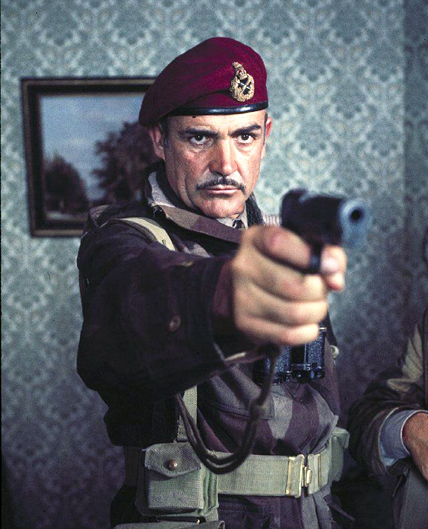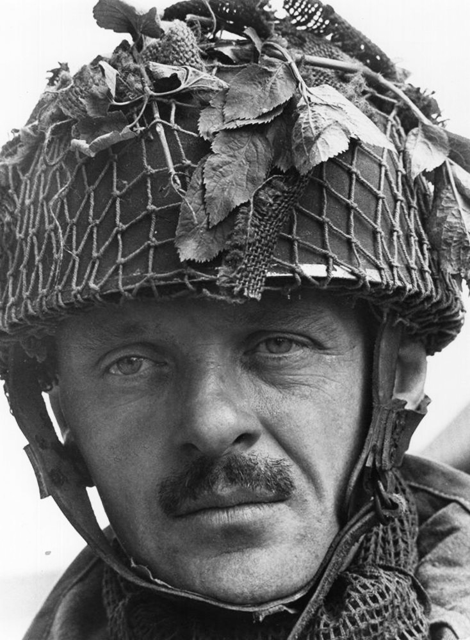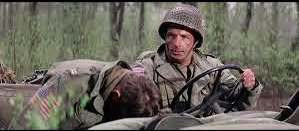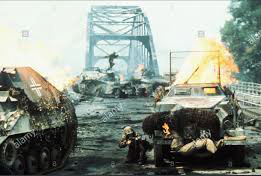In 1977, MGM released the film A Bridge Too Far, about the World War II Operation Market Garden. Following the D-Day landing, the Allies were having a hard time pushing forward on continental Europe. Field Marshal Montgomery devised the Market Garden operation as a combined land and air mission to capture all the bridges along a main road in the Netherlands, especially the bridge at Arnhem over the Rhine River. That last bridge would put the Allies in a good position to then roll eastward into Germany, with the aim of reaching Berlin.
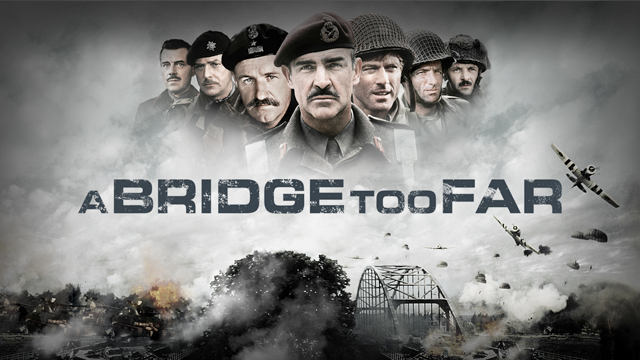
The film was loaded with high powered stars playing (for the most part) real people, with some characters fictionalized versions of other real people. The aim of the film makers was to try and make it as historically accurate as possible, without actually making a documentary. William Goldman wrote the script from the book by Cornelius Ryan, and Richard Attenborough directed it. The logistics for the film required getting as many WWII planes as possible for the air drop sequences. The actual operation involved 35,000 paratroopers (American, British, and Polish) to secure the various bridges, while the tank corps would then roll up the road, crossing the bridges, in a race to Arnhem. The production had 1,000 jumpers to film the landing sequences from their fleet of planes.
I saw the film when it was released in 1977, and I like it. I’m not a big fan of war movies, but I liked A Bridge Too Far for the clarity with which it presented the mission. I understood the stakes, the objectives were clear, the problems that turned up in the actual execution of the operation were easy to understand. And we had the vignettes of the various people who were involved in the operation, including some of the Germans that would oppose them. The sequences of the daylight jump of the thousands of paratroopers is visually spectacular. These days we have gotten used to such sequences created by computer graphics, and we nod and smile at them. But this film did the actual thing: shots from the ground of the flock of planes flying overhead, with the string of parachutes blossoming open behind each of them; shots from the planes, as the paratroopers went out the door, and their chutes popped open; even point of view shots from a jumper, all the way to the ground and the hard landing. There’s an organic feeling to it that computer graphics still cannot quite achieve.
But for all this production effort, the film did not do well. The rousing score (which I love) could not pull together what many felt was choppy storytelling. With so many characters to track, even though each is clearly delineated, it feels difficult for the audience member to connect. And indeed, there have been films made about specific aspects of Operation Market Garden, in particular, the taking of the bridge at Nijmegen and the failure to take the bridge at Arnhem, both of which have emotional stories for the commanders at those points.
Because this is about a failed operation. If the mission were an actual person, it would be a dramatic tragedy.
In reality, there was plenty of tragedy: the disastrous landing of the troops charged with the Arnhem bridge, miles from the town and bridge, in the midst of an unexpected Panzer division; the taking of the Nijmegen bridge, where the troops were obliged (because of time pressures) to cross the river in inflatable plank-and-rubber boats in daylight, with many being shot to shreds – but they took the bridge. The over-all story is not lacking in emotional human stories.
So, what kept the film from connecting with the audience?
When we go to movies, we expect to connect emotionally with the characters. We want at least one character to hang onto throughout the whole adventure. We invest our attention in that character’s ups and downs, as the character emotes, so do we.
The problem with A Bridge Too Far is that the main character we were expected to latch onto was not any of the humans involved in the operation, it is the mission itself.
As I said before, I saw the film when it was released in theaters, and I like it. It is long (about three hours, in fact), but over the years, I’ve seen it a few times again on cable. And it recently turned up on the Hulu streaming service, so I watched it again. But this time I paid attention to the story presentation.
Most of the principal characters performed by major stars have their own complete story arcs: beginning, middle, end, with the attendant conflicts, successes, and failures. We are satisfied with the completeness of these sub-stories. But there is no through-character whose point of view we can follow, other than the mission itself. And, unfortunately, the mission cannot convey to us the desperate need to get all the way up the road, the frustration of finding that most of it was very narrow and elevated, making it difficult for tanks and trucks to travel all at once. The mission cannot express alarm when the bridge at Son was blown up by the Germans, and the Allies have to use a British pontoon bridge to make that crossing. Instead, those emotions are presented by individuals we get little time with, even though their characters and concerns are clearly delineated. But the vignettes are not enough for us emotionally. Thus, when we get to the tragic ending of the British soldiers trapped at Arnhem, the need to escape the surrounding Germans, and the necessity of leaving their wounded to be captured so that the escape of the others can be covered, all this is intellectually moving, and the images are poignant, but the end effect is not enough.
After I first saw the film, I did get the book it was based on. It’s an outstanding historical read, giving much more detail about aspects of the operation (such as a footnote about embedded reporters, which included Walter Cronkite). But in a book, we can easily accept “mission as main character” because we know that is the point. But movies are like stories told around campfires: we are not expecting nor wanting a history lesson at such an occasion. We want to connect with other people, to feel as they feel, fully, from start to finish.
If you accept the film on its own terms, that the mission is the main character, and go along for the ride, it remains a repeatable experience, which is not a failure in storytelling terms. But you do feel the lack of a through-character. Field Marshal Montgomery himself never appears in the film: that raises interesting questions. Montgomery came up with the operation a bit out of jealousy: Patton was more highly regarded as a field general, and Eisenhower had overseen the massive, deadly, but successful D-Day landing. But Montgomery was never on the ground with any of the troops in Market Garden. And after the paratroopers were withdrawn from Arnhem, he pronounced the mission mostly a success. After all, it did free much of the Netherlands from the Germans. But we never see his pride, jealousy, over-confidence, chagrin, and psychological denial of the tragic failure, all because he conceived of an operation that reached for a bridge too far. But that would be a different story altogether.

